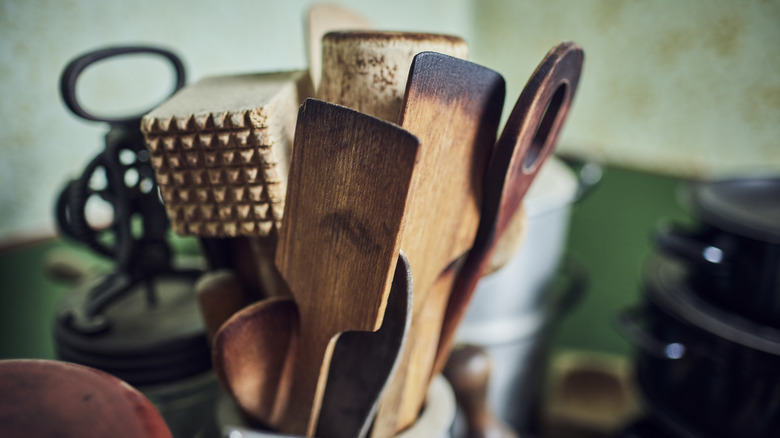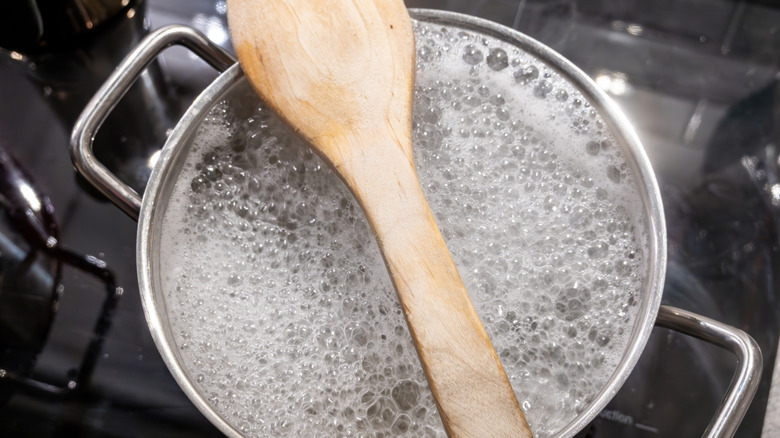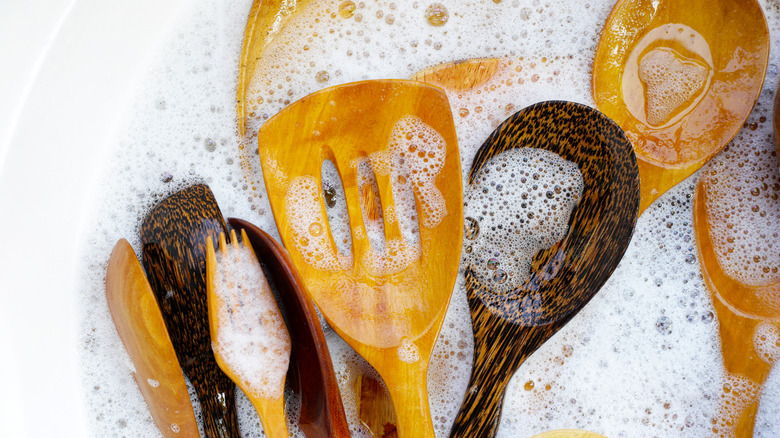Can You Disinfect Your Wooden Kitchen Utensils With Boiling Water? Here's What To Know
Wooden spoons have been around for thousands of years, and yet there is still controversy about whether they are safe to use for cooking. Some people like using wooden utensils because they do not contain harmful chemicals that can leach into food, are made of a soft material that will not scratch pots and pans, and do not conduct heat. But others worry about how hygienic they are. Wood is porous and can absorb moisture, which could lead to the growth of bacteria or even mold. Proper care can help keep your utensils clean, but you may still wonder if they are harboring bacteria or other microbes inside the wood.
One popular method people use to test the dirtiness of their wooden utensils is by placing them in boiling water. The thought behind this trend is that boiling water will disinfect the items. Plus, you will get to see the gunk left behind after the process. But before you gather your wooden utensils and turn on the burners, you should know more about the efficacy of this cleaning method. While boiling is a solid disinfecting method for some materials, putting your wooden utensils in hot water for too long can ultimately damage the wood.
How to test wooden kitchen utensils for bacteria
To perform this test, start by bringing water to a boil. Then, insert the wooden utensils you suspect of contamination. Do not use unwashed utensils as the idea is to find the hidden dirt. The general instructions are to leave the utensils in boiling water for about 30 minutes. During this time, many people report seeing the water change color. They also find that bits of debris emerge from the utensils and float around in the pot. When the time is up, remove the utensils and clean them using soap and water, before leaving them out to dry.
The thought of easily extracting all the gross parts from your utensils may seem enticing, but it is not quite as good as it sounds. The boiling water and soaking will expand the wood, which will release trapped particles, but it will also strip natural oils. These oils protect wooden utensils, so boiling the protection away is certainly not ideal. In addition, soaking can cause warping, cracking, and splintering. This is also why you should not put wooden utensils and cutting boards in the dishwasher. If you really want to try this boiling test, only leave the utensils in the water for about two to five minutes before immediately drying. Treat them with oil afterward if needed. To reduce the chance of damage, do not conduct this test often.
What to do if you believe your wooden kitchen utensils are contaminated
If the typical cleaning process is not giving you peace of mind concerning your wooden utensils, there are other ways to determine if your cooking instruments are safe. First, inspect it. If you see stains, discoloration, or fuzzy mold, you may need to put more time into scrubbing. Additionally, you can smell the utensils. If there are foul or strange odors, it is reasonable to suspect that there is something unsavory in the wood. If you suspect mold or harmful bacteria is growing in your utensils, it is probably best to throw them away since porous material like wood can be difficult to sanitize. Toss any utensils with visible cracks, which can let more bacteria in. If you are not sure about a replacement, here is how long wooden spoons should really last in your kitchen.
To prevent mold and bacteria, you should learn how to disinfect your wooden kitchen utensils properly and how best to care for them. Some types of wood have built-in antimicrobial properties, so you just need to maintain them well. Only hand wash them, and dry immediately. Applying food-grade mineral oil every month or so can also help preserve your wooden utensils. With the right care, these kitchen utensils can safely last a lifetime.


